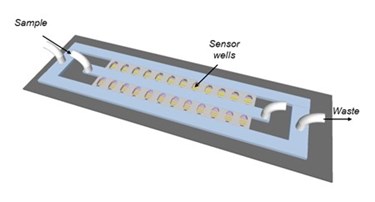New Chip Could Test For "Superbugs" In 1 Hour

Canadian scientists have developed a diagnostic tool that can test for antimicrobial-resistant (AMR) “superbugs” in hours, rather than days. Because the process is significantly shortened, the researchers believe their new chip could take the guesswork out of infection diagnostics and help clinicians prescribe effective antibiotics sooner.
A recent report commissioned by the British government estimated that AMR disease could claim 10 million lives per year and rack up a global healthcare cost of $100 trillion. The author of the report, former Goldman Sachs chief economist Jim O’Neill, called that estimate conservative, and said the real numbers probably are much higher.
According to scientists at the University of Toronto (U of T), one of the causes of antibiotic resistance is imprecise and ineffective prescribing. Because testing can take up to three days to complete and patients require a much earlier intervention, doctors often prescribe a broad-spectrum antibiotic while they wait for test results.
“Guessing can lead to resistance to these broad-spectrum antibiotics, and in the case of serious infections, to much worse outcomes for the patient. We wanted to determine whether bacteria are susceptible to a particular antibiotic, on a timescale of hours, not days,” said Justin Besant, a PhD researcher at U of T, in U of T Engineering News.
The team, which published its research in Lab on a Chip, designed a glass chip that would use a series of filters to concentrate the maximum amount of bacteria in a nano-sized well containing antibiotic and a molecule called resazurin. When living bacteria reacts with resazurin, it changes into resorufin, which has a different electrochemical signature. If the antibiotic successfully kills the bacteria, researchers explained, the reaction would stop.
Study authors report, “This electrochemical phenotyping approach is effective with clinically relevant levels of bacteria, and provides results comparable to culture-based analysis. Results, however, are delivered on a much faster timescale, with resistance profiles available after one hour incubation period.”
Edward Sargent, a U of T professor of electrical and computer engineering, supervised the project with Shana O. Kelley, a professor at the Institute for Biomaterials and Biomedical Engineering. Sargent said the tool could be used in a doctor’s office to provide quick results, all in a package that is considerably less bulky than current rapid alternatives.
“The electronics for our electrochemical readout can easily fit in a very small benchtop instrument, and this is something you could see in a doctor’s office, for example,” said Besant. “The next step would be to create a device that would allow you to test many different antibiotics at many different concentrations, but we’re not there yet.”
